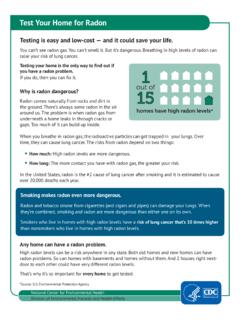Transcription of National Vital Statistics Reports
1 National Vital Statistics Reports Volume 70, Number 8 July 26, 2021 DEPARTMENT OF HEALTH AND HUMAN SERVICES Centers for Disease Control and Prevention National Center for Health Statistics National Vital Statistics System Abstract Objectives This report presents final 2019 data on deaths, death rates, life expectancy, infant and maternal mortality, and trends by selected characteristics such as age, sex, Hispanic origin and race, state of residence, and cause of death. The race categories are consistent with 1997 Office of Management and Budget (OMB) standards, different from Reports prior to 2018, which followed 1977 OMB standards. Methods Information reported on death certificates is presented in descriptive tabulations. The original records are filed in state registration offices. Statistical information is compiled in a National database through the Vital Statistics Cooperative Program of the National Center for Health Statistics .
2 Causes of death are processed according to the International Classification of Diseases, 10th Revision. Beginning in 2018, all states and the District of Columbia were using the 2003 revised certificate of death for the entire year, which includes the 1997 OMB revised standards for race. The 2019 and 2018 data based on the revised standards are not completely comparable to previous years. Selected estimates are presented in this report for both the revised and previous race standards to provide some reference for interpretation of trends. Results In 2019, a total of 2,854,838 deaths were reported in the United States. The age-adjusted death rate was deaths per 100,000 standard population, a decrease of from the 2018 rate. Life expectancy at birth was years, an increase of year from 2018. Age-specific death rates decreased in 2019 from 2018 for age groups 45 54, 65 74, 75 84, and 85 and over and increased for age group 35 44.
3 The 15 leading causes of death in 2019 remained the same as in 2018, although two causes exchanged ranks. Influenza and pneumonia, the eighth leading cause of death in 2018, became the ninth leading cause of death in 2019, while kidney disease, the ninth leading cause of death in 2018, became the eighth leading cause of death in 2019. The infant mortality rate, infant deaths per 1,000 live births in 2019, remained a historic low but was not statistically different from the rate in 2018. Conclusions In 2019, the age-adjusted death rate decreased and life expectancy at birth increased for the total, male, and female populations for the second consecutive year. Keywords: mortality cause of death life expectancy National Vital Statistics System Highlights Mortality experience in 2019 In 2019, a total of 2,854,838 resident deaths were registered in the United States, yielding a crude death rate of per 100,000 population.
4 The age-adjusted death rate, which accounts for the aging of the population, was deaths per 100,000 standard population. Life expectancy at birth was years. The 15 leading causes of death in 2019 were: 1. Diseases of heart (heart disease) 2. Malignant neoplasms ( cancer ) 3. Accidents (unintentional injuries) 4. Chronic lower respiratory diseases 5. Cerebrovascular diseases (stroke) 6. Alzheimer disease 7. Diabetes mellitus (diabetes) 8. Nephritis, nephrotic syndrome and nephrosis (kidney disease) 9. Influenza and pneumonia 10. Intentional self-harm (suicide) 11. Chronic liver disease and cirrhosis 12. Septicemia 13. Essential hypertension and hypertensive renal disease (hypertension) 14. Parkinson disease 15. Pneumonitis due to solids and liquids NCHS Reports can be downloaded from: Deaths: Final Data for 2019 by Jiaquan Xu, , Sherry L. Murphy, , Kenneth D. Kochanek, , and Elizabeth Arias, , Division of Vital Statistics 2 National Vital Statistics Reports , Vol.
5 70, No. 8, July 26, 2021 In 2019, the infant mortality rate was infant deaths per 1,000 live births. The 10 leading causes of infant death were: 1. Congenital malformations, deformations and chromosomal abnormalities (congenital malformations) 2. Disorders related to short gestation and low birth weight, not elsewhere classified (low birth weight) 3. Accidents (unintentional injuries) 4. Sudden infant death syndrome (SIDS) 5. Newborn affected by maternal complications of pregnancy (maternal complications) 6. Newborn affected by complications of placenta, cord and membranes (cord and placental complications) 7. Bacterial sepsis of newborn 8. Respiratory distress of newborn 9. Diseases of the circulatory system 10. Necrotizing enterocolitis of newborn Comparison to previous year The age-adjusted death rate decreased from per 100,000 standard population in 2018 to in 2019. The age-adjusted death rate was times greater for the non-Hispanic black population ( ) than for the non- Hispanic white population ( ).
6 The age-adjusted death rate for the non-Hispanic white population ( ) was times greater than for the Hispanic population ( ). Life expectancy for the total population increased year from in 2018 to in 2019. Life expectancy for females was years higher than for males, an increase of year from 2018. The difference in life expectancy between the sexes has narrowed since 1979, when it was years. Life expectancy in 2019 for the Hispanic population was years higher than for the non-Hispanic white population. The difference in life expectancy between the non-Hispanic white and non-Hispanic black populations increased year from years in 2018 to years in 2019. From 2018 and 2019, life expectancy increased for non- Hispanic white males ( year), non-Hispanic white females ( year), non-Hispanic black females ( year), and Hispanic females ( year).
7 Life expectancy decreased year for non-Hispanic black males. The 15 leading causes of death in 2019 were the same as in 2018, although Influenza and pneumonia exchanged ranks with kidney disease. Age-adjusted death rates decreased significantly in 2019 from 2018 for 9 of the 15 leading causes of death: heart disease, cancer , Chronic lower respiratory diseases, Alzheimer disease, kidney disease, Influenza and pneumonia, suicide, Septicemia, and Pneumonitis due to solids and liquids. Significant increases occurred in 2019 from 2018 for 2 of the 15 leading causes of death: unintentional injuries, and Chronic liver disease and cirrhosis. Age-adjusted death rates increased in 2019 from 2018 for drug-induced causes ( ) and for alcohol-induced causes ( ). The increase in life expectancy at birth for the total population in 2019 was mainly due to decreases in mortality from cancer , Chronic lower respiratory diseases, Influenza and pneumonia, and suicide.
8 Among external causes of injury death, unintentional poisoning has been the leading mechanism of injury mortality since 2011. The infant mortality rate of infant deaths per 1,000 live births in 2019 remained a record low, but the difference from the rate in 2018 ( ) was not statistically significant. Five out of the 10 leading causes of infant death in 2019 changed ranks from 2018. Introduction This report presents detailed 2019 data on deaths and death rates according to a number of demographic and medical characteristics. These data provide information on mortality patterns among residents of the United States by such variables as age, sex, Hispanic origin and race, state of residence, and cause of death. Information on these mortality patterns is key to understanding changes in the health and well-being of the population (1).
9 Companion Reports present additional details on leading causes of death and life expectancy in the United States (2,3). Mortality data in this report can be used to monitor and evaluate the health status of the United States in terms of current mortality levels and long-term mortality trends, and to identify segments of the population at greater risk of death from specific diseases and injuries. Differences in death rates among various demographic subpopulations, including racial and ethnic groups, may reflect subpopulation differences in factors such as socioeconomic status, access to medical care, and the prevalence of specific risk factors in a particular subpopulation. The 2003 revision of the Standard Certificate of Death uses the revised 1997 Office of Management and Budget (OMB) Standards for the collection of race and Hispanic ethnicity (4,5).
10 The 1997 standards allow individuals to report more than one race and increase the race choices from four to five by separating the Asian and Pacific Islander groups. Beginning with the 2018 data year, all 50 states and the District of Columbia reported deaths based on the 2003 revision for the entire year, so the revised standards became the official standards for presenting mortality data by race and ethnicity (6). The category Hispanic did not change, remaining consistent with Reports prior to 2018. The new categories in this report include non-Hispanic white; non-Hispanic black or African American; non-Hispanic American Indian or Alaska Native (AIAN); non-Hispanic Asian; and non- Hispanic Native Hawaiian or Other Pacific Islander (NHOPI). Data presented in this report according to the new race and Hispanic- origin categories represent the official data by race and origin for 2018 and 2019.












